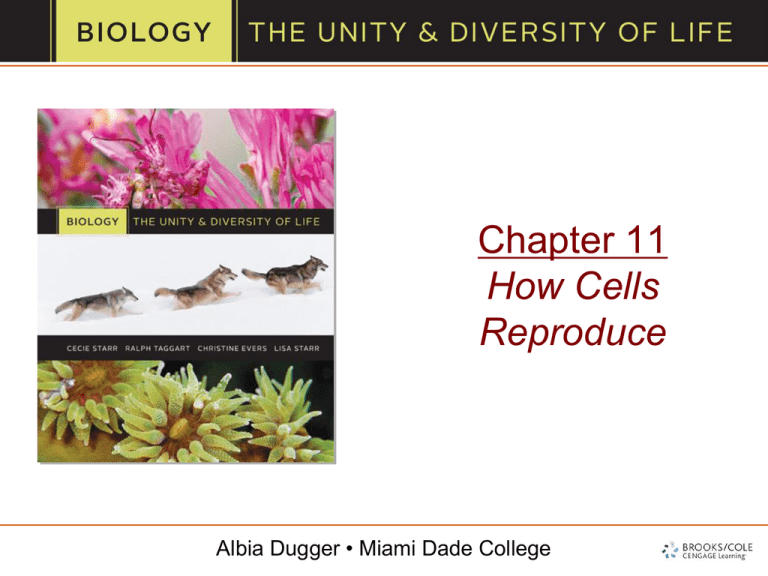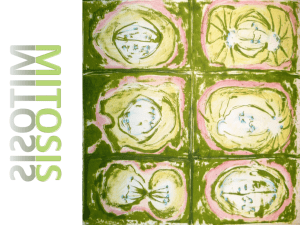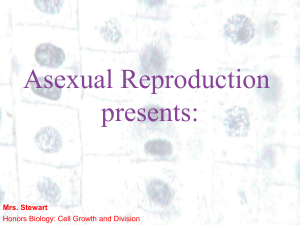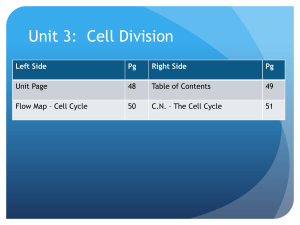
Chapter 11
How Cells
Reproduce
Albia Dugger • Miami Dade College
11.1 Henrietta’s Immortal Cells
• Henrietta Lacks died of cancer in 1951, at age 31, but her
cells (HeLa cells) are still growing in laboratories
• HeLa cells are widely used to investigate cancer, viral growth,
protein synthesis, the effects of radiation, and other
processes important in medicine and research
• Understanding why cancer cells are immortal – and why we
are not – begins with understanding the structures and
mechanisms that cells use to divide
HeLa Cells
11.2 Multiplication by Division
• Division of a eukaryotic cell typically occurs in two steps:
nuclear division followed by cytoplasmic division
• The sequence of stages through which a cell passes during
its lifetime is called the cell cycle
The Life of a Cell
• Cell cycle
• A sequence of three stages (interphase, mitosis, and
cytoplasmic division) through which a cell passes between
one cell division and the next
Interphase
• Interphase consists of three stages, during which a cell
increases in size, doubles the number of cytoplasmic
components, and replicates its DNA
• G1: Interval of cell growth and activity
• S: Interval of DNA replication (synthesis)
• G2: Interval when the cell prepares for division
Interphase and the Life of a Cell
• Most cell activities take place during G1
• Control mechanisms work at certain points in the cell cycle;
some can keep cells in G1
• Loss of control may cause cell death or cancer
Mitosis and Asexual Reproduction
• Mitosis is a nuclear division mechanism that maintains the
chromosome number
•
In multicelled species, mitosis and cytoplasmic division
increase cell number during development , and replace
damaged or dead cells later in life
• In asexual reproduction, a single individual can reproduce
by mitosis and cytoplasmic division
Cell Division in Frog Embryos
Homologous Chromosomes
• Homologous chromosomes are pairs of chromosomes
having the same length, shape, and genes
• Typically, one member of a homologous pair is inherited from
the mother, the other from the father
• Human cells have 46 chromosomes (23 pairs)
• Except for a pairing of sex chromosomes (XY) in males, the
chromosomes of each pair are homologous
Chromosomes During Division
• A cell can’t function without a full complement of DNA – each
cell needs to have one copy of each chromosome
• The cell replicates its DNA in preparation for mitosis
• Four stages of mitosis (prophase, metaphase, anaphase, and
telophase) parcel sister chromatids into separate nuclei
• Cytoplasmic division results in two diploid cells, each with
the same number and kind of chromosomes as the parent
A An unduplicated pair of
chromosomes in a cell in G1.
B By G2, each chromosome
has been duplicated.
C Mitosis and cytoplasmic division package
one copy of each
chromosome into each
of two new cells.
Stepped Art
Figure 11-4 p179
Controls Over the Cell Cycle
• Most differentiated human cells are in G1 – some types never
progress past that stage
• When a cell divides is determined by gene expression
controls; some cause the cell cycle to advance, others stop
the cycle from proceeding
• These built-in checkpoints allow problems to be corrected
before the cycle proceeds
interphase
prophase
G2
metaphase
S
mitosis
anaphase
telophase
G1
Figure 11-2 p177
ANIMATED FIGURE: The cell cycle
To play movie you must be in Slide Show Mode
PC Users: Please wait for content to load, then click to play
Mac Users: CLICK HERE
Take-Home Message:
What is cell division and why does it occur?
• The sequence of stages through which a cell passes during
its lifetime (interphase, mitosis, and cytoplasmic division) is
called the cell cycle
• A eukaryotic cell reproduces by division: nucleus first, then
cytoplasm; each descendant cell receives a set of
chromosomes and some cytoplasm
• Mitosis is the basis of body size increases and tissue repair in
multicelled eukaryotes; it is also the basis of asexual
reproduction in single-celled and some multicelled eukaryotes
• Gene expression controls advance, delay, or block the cell
cycle in response
11.3 A Closer Look at Mitosis
• When a nucleus divides by mitosis, each new nucleus has the
same chromosome number as the parent cell
• The four main stages of mitosis are prophase, metaphase,
anaphase, and telophase
Preparing for Mitosis
• During interphase, a cell’s chromosomes are loosened to
allow transcription and DNA replication
• In preparation for nuclear division, chromosomes condense
into their most compact “X” forms
• Tight condensation keeps the chromosomes from getting
tangled and breaking during nuclear division
Interphase in Plant and Animal Cells
Onion root cell
Whitefish embryo cell
3D ANIMATION: Mitosis
Prophase
• Prophase
• Chromosomes condense
• Microtubules form a bipolar spindle
• Nuclear envelope breaks up
• Microtubules attach to the chromosomes
• Centrosome
• A region near the nucleus that organizes spindle
microtubules; usually includes two centrioles
The Spindle
• Spindle
• A dynamic network of microtubules that forms during
nuclear division
• Grows into the cytoplasm from opposite poles of the cell
and attaches to duplicated chromosomes
• Microtubules from opposite poles attach to different sister
chromatids and separate them
Metaphase and Anaphase
• Metaphase
• All duplicated chromosomes line up midway between the
spindle poles
• Anaphase
• Microtubules separate the sister chromatids of each
chromosome and pull them to opposite spindle poles
Telophase
• Telophase
• Two clusters of chromosomes reach the spindle poles
• A new nuclear envelope forms around each cluster
• Two new nuclei are formed, each with the same chromosome
number as the parent cell
Mitosis
Take-Home Message:
What is the sequence of events in mitosis?
• Each chromosome in a cell’s nucleus was duplicated before
mitosis begins, so each consists of two DNA molecules
• Mitosis proceeds in four stages: prophase, metaphase,
anaphase, and telophase
• During these four stages, sister chromatids of the duplicated
chromosomes are separated and packaged into two new
nuclei; each new nucleus contains the same number and
types of chromosomes as the parent cell
11.4 Cytokinesis: Division of Cytoplasm
• In most kinds of eukaryotes, the cell cytoplasm divides
between late anaphase and the end of telophase, but the
mechanism of division differs between plants and animals
• Cytokinesis
• The process of cytoplasmic division
Cytokinesis in Animal and Plant Cells
• Animal cells
• A cleavage furrow partitions the cytoplasm
• A band of actin filaments rings the cell midsection,
contracts, and pinches the cytoplasm in two
• Plant cells
• A cell plate forms midway between the spindle poles; it
partitions the cytoplasm when it reaches and connects to
the parent cell wall
Cytoplasmic Division in Animal Cells
1 After mitosis is completed, the spindle
begins to disassemble.
2
At the midpoint of the former spindle, a
ring of actin and myosin filaments
attached to the plasma membrane
contracts.
3 This contractile ring pulls the cell
surface inward as it shrinks.
4 The ring contracts until it pinches
the cell in two.
ANIMATED FIGURE: Cytoplasmic division
To play movie you must be in Slide Show Mode
PC Users: Please wait for content to load, then click to play
Mac Users: CLICK HERE
Cytoplasmic Division in Plant Cells
5
The future plane of division was
established before mitosis began.
Vesicles cluster here when mitosis ends.
6
As the vesicles fuse with each other,
they form a cell plate along the plane of
division.
7
The cell plate expands outward along the
plane of division. When it reaches the
plasma membrane, it attaches to the
membrane and partitions the cytoplasm.
8
The cell plate matures as two new cell
walls. These walls join with the parent cell
wall, so each descendant cell becomes
enclosed by its own cell wall.
Take-Home Message:
How do cells divide?
• After mitosis, the cytoplasm of the parent cell typically is
partitioned into two descendant cells, each with its own
nucleus
• In animal cells, a contractile ring pinches the cytoplasm in two
• In plant cells, a cell plate that forms midway between the
spindle poles partitions the cytoplasm when it reaches and
connects to the parent cell wall
11.5 Marking Time With Telomeres
• Telomeres protect eukaryotic chromosomes from losing
genetic information at their ends
• Shortening telomeres are associated with aging
Telomeres
• The ends of eukaryotic DNA strands consist of noncoding
sequences called telomeres
• Vertebrate telomeres have a short DNA sequence, 5′TTAGGG-3′, repeated thousands of times
• Telomeres are important because a polymerase can’t copy
the last hundred or so bases of the 3′ end of a chromosome
• When telomeres get too short, checkpoint gene products stop
the cell cycle, and the cell dies
Stem Cells and Telomerase
• In an adult, only stem cells retain the ability to divide
indefinitely
• Stem cells are immortal because they retain the ability to
make telomerase, a molecule that reverses telomere
shortening that normally occurs after DNA replication
• Research suggests that the built-in limit on cell divisions may
be part of the mechanism that sets an organism’s life span
Telomeres
Take-Home Message:
What is the function of telomeres?
• Telomeres at the ends of chromosomes provide a buffer
against loss of genetic information
• Telomeres shorten with every cell division in normal body
cells; when they get too short, the cell stops dividing and dies
11.6 When Mitosis Becomes Pathological
• On rare occasions, controls over cell division are lost and a
neoplasm forms
• Cancer develops as cells of a neoplasm become malignant
Checkpoint Failure and Tumors
• When enough checkpoint mechanisms fail, a cell loses
control over its cell cycle forms a neoplasm – a group of cells
that lost control over how they grow and divide
• A neoplasm that forms a lump (abnormal mass) in the body is
called a tumor
Oncogenes and Proto-Oncogenes
• An oncogene is any gene that helps transform a normal cell
into a tumor cell
• Genes encoding proteins that promote mitosis are called
proto-oncogenes – mutations can turn them into oncogenes
• Growth factors are molecules that stimulate a cell to divide
and differentiate
• A gene that encodes the epidermal growth factor (EGF)
receptor is an example of a proto-oncogene
Oncogenes and Overactive EGF Receptors
Tumor Suppressors
• Checkpoint gene products that inhibit mitosis are called
tumor suppressors because tumors form when they are
missing
• The products of the BRCA1 and BRCA2 genes are examples
of tumor suppressors – they regulate the expression of DNA
repair enzymes
Checkpoint Genes in Action
Cancer
• Benign neoplasms (such as ordinary skin moles) grow slowly,
stay in one place, and are not cancerous
• Malignant neoplasms (cancers) disrupt body tissues, both
physically and metabolically
Three Characteristics of Cancer Cells
1. Cancer cells grow and divide abnormally; capillary blood
supply to the cells may increase abnormally
2. Cytoplasm and plasma membrane are altered; malignant cells
typically have an abnormal chromosome number, and
metabolism may shift toward fermentation
3. Cancer cells have altered recognition proteins and weakened
adhesion – malignant cells break loose and invade other parts
of the body (metastasis)
1 Benign neoplasms
2 Cells of a
grow slowly and stay
in their home tissue.
malignant neoplasm
can break away
from their home
tissue.
3 The malignant cells become
attached to the wall of a blood
vessel or lymph vessel. They
release digestive enzymes
that create an opening in the
wall, then enter the vessel.
4 The cells creep or tumble
along inside blood vessels,
then leave the bloodstream
the same way they got in.
They often start growing in
other tissues, a process
called metastasis.
Figure 11-11 p185
ANIMATED FIGURE: Cancer and
metastasis
To play movie you must be in Slide Show Mode
PC Users: Please wait for content to load, then click to play
Mac Users: CLICK HERE
Reducing the Risk of Cancer
• Each year, cancer causes 15 to 20 percent of all human
deaths in developed countries
• Life style choices such as not smoking and avoiding exposure
of unprotected skin to sunlight can reduce the risk of acquiring
mutations that lead to cancer
• Some neoplasms can be detected with periodic screening
procedures such as Pap tests or dermatology exams
Skin Cancers
A Basal cell carcinoma is the most
common type of skin cancer. This
slow- growing, raised lump may be
uncolored, reddish- brown, or black.
B The second most common form of
skin cancer is a squamous cell
carcinoma. This pink growth, firm to
the touch, grows under the surface
of skin.
Take-Home Message:
What is cancer?
• Cancer is a disease that occurs when the abnormally dividing
cells of a neoplasm physically and metabolically disrupt body
tissues
• A malignant neoplasm results from mutations in multiple
checkpoint genes
• Although some mutations are inherited, life style choices and
early intervention can reduce one’s risk of cancer
Video: Genetics, Sociology, and Breast
Cancer










